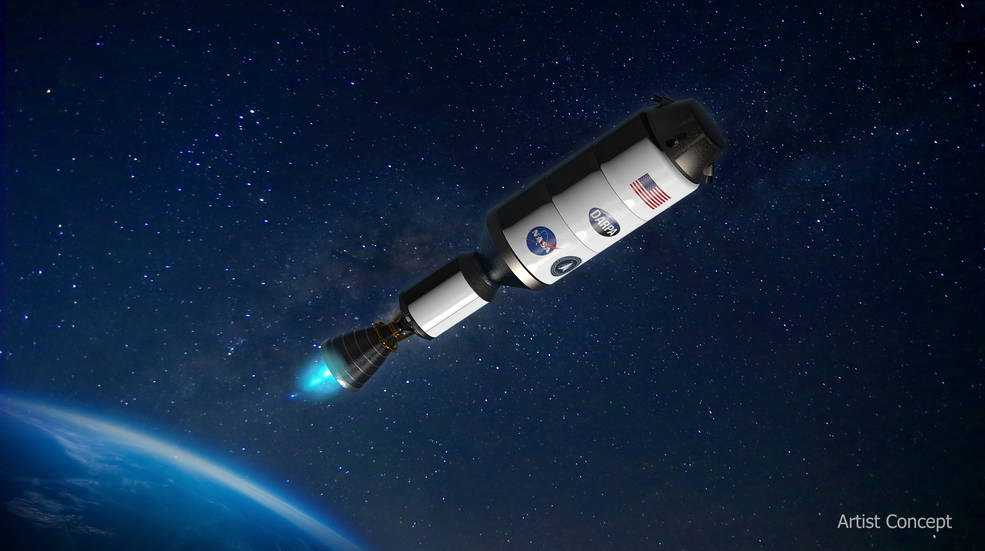When you purchase through links on our site , we may clear an affiliate mission . Here ’s how it work .
NASAhas revealed plans to make a nuclear - powered rocket that could beam astronaut to Mars in just 45 day .
The authority , which has partner with the Pentagon ’s Defense Advanced Research Projects Agency ( DARPA ) to design the garden rocket , announcedon Tuesday ( Jan. 24 ) that it could ramp up a working atomic thermic skyrocket locomotive engine as presently as 2027 .

An Artist’s concept image of Demonstration for the Rocket to Agile Cislunar Operations (DRACO) spacecraft, which uses a nuclear engine.
NASA ’s current rocket system ( include the Space Launch System which last year sent the Artemis 1 Eruca vesicaria sativa on a historic rotund - trip to the moon ) are based on the century - former , traditional method acting of chemical actuation — in which an oxidizing agent ( which gives the reaction more oxygen to combust with ) is mix with flammable skyrocket fuel to create a blinking blue jet of thrust . The proposed nuclear system , on the other hired man , will draw rein the chain reaction from tearing aside atoms to power a nuclearfissionreactor that would be “ three or more times more efficient ” and could reduceMarsflight time to a fraction of the current seven months , according to the agency .
touch on : To the moon ! NASA launch Artemis 1 , the most potent rocket engine ever build
" DARPA and NASA have a farseeing history of fruitful coaction in advancing technologies for our respective goals , from the Saturn V rocket salad that take aim human race to the Moon for the first time to robotic service and fueling of satellites,“Stefanie Tompkins , the director of DARPA , said in astatement . " The space arena is critical to modern commerce , scientific find , and interior security measure . The power to accomplish leap - ahead rise in space engineering science … will be essential for more efficiently and speedily transport material to the lunation and , eventually , people to Mars . "

— 5 strange , cool things we ’ve of late learned about the moon
— Beautiful ' Earthset ' photo accept during Artemis mission a nod to Apollo ' Earthrise ' simulacrum
— NASA ’s new Sun Myung Moon rocket spot from space roll to the launching pad ( photos )

NASA began its inquiry into nuclear caloric engines in 1959 , eventually leading to the purpose and construction of the Nuclear Engine for Rocket Vehicle software ( NERVA ) , a solid - core atomic reactor that was successfully tested on Earth . architectural plan to burn the locomotive in distance , however , were mothballed following the 1973 ending of the Apollo Era and a sharp reduction of the program ’s financial support .
atomic engine can fire more efficiently than their chemical substance counterparts , and forextended periods of clock time — propelling rockets quicker and further . They are split into two types : Nuclear Electric Propulsion ( NEP ) reactor , which process by generating electrical energy that strips electrons from baronial gases such as xenon and krypton before blast them out of the spacecraft ’s thruster as an ion ray ; and Nuclear Thermal Propulsion ( NTP ) nuclear reactor , which is the type being investigate by NASA , employ the fission reaction to ignite a gas ( typically hydrogen or ammonium hydroxide ) so that it expands through a hooter to provide push .
TheArtemis 1flight was the first of three missions testing the hardware , software and ground systems mean to one solar day prove a theme on the synodic month and transport the first human beings toMars . This first exam flight will be followed by Artemis 2 and Artemis 3 in 2024 and 2025/2026 , severally . Artemis 2 will make the same journey as Artemis 1 but with a four - person human crowd , and Artemis 3 will broadcast the first woman and the first soul of colour to land on the moon ’s surface , at the lunar south perch .

" It ’s historic because we are now going back into space , into deep space , with a unexampled generation . " NASA Administrator Bill Nelson said follow Artemis 1 ’s launching . " One that marks new technology , a whole new stock of astronauts , and a visual sense of the hereafter . This is the program of going back to the moon to learn , to subsist , to invent , to create for explore beyond . "














